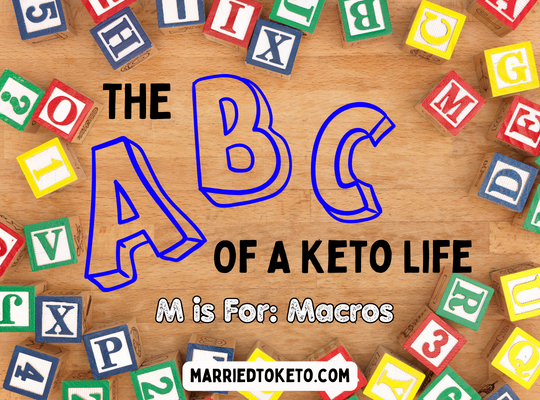What’s the first thing we learn as children? Our ABC’s. So, we thought it would be a fun idea to do the ABC’s of keto! This blog series looks at some of the main ideas and the not-so-main ideas of keto as we work our way through the alphabet. The next one in our series is: M is for macros on keto.
What are Macros?
Macros is a term used to describe the three macronutrients found in food. They are fat, carbohydrates, and protein. There are different amounts of each in our food. Some are solely one macro, but most have a little of each or at least two out of the three. For example, meat has both fat and protein. Vegetables have carbs and sometimes protein as well. Micronutrients are the vitamins and minerals you find in food.
How to Find the Macros on Keto Food
The easiest way to determine macros on food is to read the nutritional label. These labels are on all packaged food. They have the serving size and the amount of calories per serving on the top of the label. Then, they have the macros listed. It will tell you how many grams of fat, carbohydrates, and protein there is in each serving. Also listed under the carbs is the amount of sugar and the amount of fiber. Then, the label lists the micronutrients below that.
But, what about the foods that don’t have labels? This includes the whole foods we talk about being so important. Where do you get the information on that? It’s a little tricker. You can find the information online, but every site will use different serving sizes and may give information that is just a tiny bit different. Apps like My Fitness Pal and Carb Manager are great, but depends a lot on people entering the information so are not necessarily reliable.
I recently found a website called Eat This Much and it is great for foods that don’t have labels. You can look up the meat, vegetables, and fruit that don’t come with labels and it offers a quick and easy way to read the information. If you create a recipe, it will calculate the nutritional information for you. You can also use the USDA website to find nutritional information for whole foods. It’s more accurate, but I don’t find it as user-friendly.
What are the Ideal Macros on Keto Diets?
Ideally, your macros on a keto diet are 70% fat, 20% protein, and 10% carbs. Your total number of carbs should be 20-50 grams a day at maximum. We try to keep ours around 20 grams. It is important to keep track of your macros on keto so you get into ketosis and stay there.
People tend to focus on the low carbs, which is great, but you also need to keep your fat and protein numbers up. If you simply cut out carbs but you don’t give your body the fat it needs to switch into ketosis, you are just starving your body. Yes, keep your carbs down, but also keep your fat up so you are providing your body what it needs for energy.

That’s for keto. People who are not on keto also count their macros. It just depends on what you want from your body. Bodybuilders count macros to ensure they are getting enough protein for muscle building. For weight loss, you count macros to ensure you are either cutting down on fat or carbs.
How to Count Macros
Okay, so counting macros on keto is not easy – it takes a little math. First, you have to figure out how many calories you want to take in a day. You can find calculators online that will help you decide, but generally women need 2000 calories a day and men need 2500 calories a day. Anything lower than that, you should really check with your doctor.
Now, to figure out your macros, you need to know that a gram of fat has 9 calories. One gram of both carbs and protein has 4 calories. So, let’s look at a food that has all three macronutrients – eggs. One egg has about 6 grams of fat, 1 gram of carbs, and 7 grams of protein. To find the percentages of macros in the egg, you multiply the grams of fat by 9, and the grams of both protein and carbs by 4. Then you divide each by the number of calories in the egg (86). You end up with the egg being 63% fat, 5% carbs, and 32% protein.
Does this sound like a foreign language? It’s okay. We have it on our website if you want to take another look. Or, you can simply find an online calculator that will do all the hard work for you. Just remember that it will not work out perfectly for you. The percentages often don’t work out to 100% because you are rounding up or because you are using net carbs instead of the total number due to fiber numbers.
The Pros and Cons of Counting Macros on Keto
So, counting macros is a lot of work. Even if you use an online source, it’s still putting in the numbers and tracking everything you eat. That means most people will either stop doing it or will become obsessed with it. If you are becoming obsessed, you should talk to your doctor to ensure it isn’t turning into an unhealthy habit.
But, we recommend counting your macros at least while you get started on keto. It makes you accountable for what you are putting into your body. And, it’s really easy to underestimate what you are eating. We spend our entire lives eating, so we tend to do it without thinking. Taking the time to record what you are putting into your body can be really beneficial. Keto is work, but in our opinion it is worth it. So, put the work into it at first and it will just get easier.
Wendy



